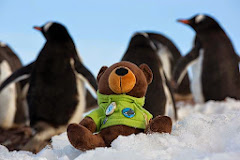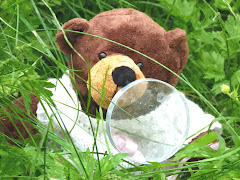Hi
Today, Methea asked me if I would help her check out the marine invertebrate aquarium which Methea uses to teach the kids about marine invertebrates and coral reefs. Methea told me it had been several months since she had done a water change on the aquarium which holds 180 gallon (681 litres) saltwater. The tank is home for various invertebrates ranging from tube worms to hermit crabs, and includes corals and sea anemones.
Hammerhead coral
Methea's favourite hermit crab
We began by siphoning out almost 50 gallons (189 litres) of the tanks water. That's a lot of water.
Methea put a long plastic pipe into the tank and sucked gently until water started to run out the other end. It takes a long time to siphon so I spent some time fishing in the tank while we waited for it to drain.
Me fishing
This was very relaxing, but don't worry, there were not any fish in there to catch - but I learnt from Ron Hirschi from Project Soar that fishing is great fun.
I then helped Methea to mix new seawater to replace what we had siphoned out. It does seem odd that we had to "mix" water.

I thought that sea water was like tap water with salt added, but seawater is actually made up of lots of other things too. These substances include Chloride, Sodium, Sulphate, Magnesium, Calcium, Potassium, Bicarbonate and Bromide which I had not heard of before. Methea said there was also small amount of other substances such as copper, iron and even gold. I asked Methea that if I was to let some seawater evaporate, would I be able to get gold from it. Sadly, Methea said this was such a tiny amount you would not even see it. Oh well, probably just as well, the oceans have enough problems without people trying to turn the ocean's water into gold! Methea told me that all of these extra substances in seawater come from rocks that are worn away by the waves and some are washed down rivers. This means each river has its own particular taste! This is why fish, such as salmon, that return to rivers from the ocean to spawn (lay eggs) can find the river where they originally hatched from a tiny egg all those years ago. They remember the taste.
Spokane is too far from the ocean for Methea to get real sea water, so we needed to put all those extra things into fresh water before we could put it into the aquarium. Luckily we did not have to add all of these different substances one at a time, we used a mixture called Instant Ocean. Just the right amount of instant ocean needs to be mixed to water so that the water is not too salty and not to dilute. It has to be the same as if it had come from the ocean.
After refilling the tank Methea gave me some extra calcium and phytoplankton (plant plankton) to put in the aquarium. The corals and other hard-shelled animals in the tank use a lot of calcium so we not only mixed it in with the new water but we also added more calcium in a liquid solution. These animals need the calcium to build their shells (just like bears and humans need calcium for strong bones).
Next I added the phytoplankton (plant plankton), which is a very important food source for many filter-feeding animals such as tube worms and corals. They catch tiny plant plankton for food. You may remember I helped my buddy Steve run a course on sharks back in September (see blog entry 20th September 2009).
We showed kids how plant plankton is important to all marine animals even big creatures such as sharks, as it is at the bottom of most marine food chains. Some sharks, such as basking sharks and whale sharks actually eat plankton too!
Here are some of the animals that feed on the phytoplankton, including the tube worms, and corals
Feather duster tube worm
Stony Coalhead Coral
Pink Coral
Torch coral
Once we had the water chemistry in sorted out Methea showed me how to check the tanks filters, pumps and hoses. These filters and pumps keep water circulating around the tank and keep it healthy.
Without this equipment, the water would become stale and the animals would die. These animals may live underwater but they still need oxygen to survive which they get from the water. The water must also be the correct temperature all around the aquarium.
Luckily, we discovered that the filters and pumps were working just fine. Methea showed me the electronic sensors that she uses to monitor temperature and pH.
Close up of temperature graph on the monitor showing how the temperature rises and falls. As long as this stays with a certain temperature range this is fine, well quite natural really.
Water pH is a way of checking to see how acid or alkaline the water is. It’s a bit complicated to explain here everything Methea told me about it so you could Google more facts. Basically pH is an important part of the water chemistry, river fish tend to like water that is a bit acid, saltwater fish tend to like water that is a bit alkali.
Methea and I finished our maintenance of the tank by hand feeding the cleaner shrimp, and hammer head corals which was great fun. These animals not only need phytoplankton but also need these meat and vitamin supplement. The cleaner shrimp scavenges of bits of debris in the tank. The strombus snial helps keep the tank clean by eating the algae that grows on the grass tank.
Strombus
Phew! That was hard work, but great fun and I learned a lot about the oceans, just as Methea said I would. It’s amazing to think how much work you have to do to keep just a small piece of ocean in an aquarium healthy. All this work the ocean does naturally everyday with the help of ocean currents. In a real coral reef the cycling of the tides and water movement, would keep water quality just right and provide the coral reef animals with a balanced diet of food. In the wild there is a delicate balance between the plankton feeders and the hunters. They all have special ways of catching food and ways to avoid being eaten. So the animals and the water chemistry are kept in a natural balance without any need for interference from humans.
Even with all this careful monitoring Methea said we still cannot keep all the corals healthy all the time. Methea said one of her favorite corals recently died off for unknown reasons.
The brown part is alive and the white part has died.
So Methea’s marine aquarium shows just how complicated the oceans are as they need no help controlling water temperature, pH, salinity (saltiness), keeping the water rich with oxygen, filtering out animal waste and natural chemicals and turning them into harmless substances and much more. All done naturally.
However, this also illustrates that this complicated habitat can be easily damaged by humans. Dumping chemicals in the ocean that should not be there and removing things that should, can only cause harm to the oceans health.
Bye for now, from a very tired little bear.






















No comments:
Post a Comment